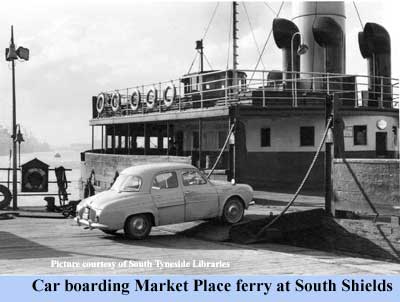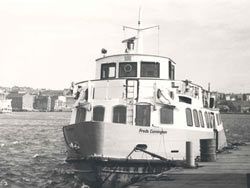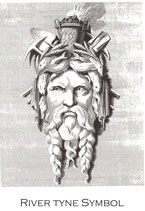
TYNE FERRIES AND TUNNELS

A ferry between North and South Shields was running by 1377, when Shields men were forbidden to bring in fish on the ferry-boat.
Crossing The Tyne. Frank Manders and Richard Potts. 2001
When there were few bridges on the Tyne during medieval times and up to the 18th century, ferries and fords were the only alternatives for most. At places it was possible to wade across but there were obvious dangers at high tide or times of flood. The early ferries were simply a small rowing boat operated by a boatman. When Tyneside expanded in the industrial era such boats were inadequate. The development of steam power enabled a more sophisticated type of ferry carrying larger numbers of passengers, plus vehicles to be provided between North and South Shields and at other points further up river where large numbers of people, mainly workmen, needed to cross. In rural areas the ferries were still used, but bridges were increasingly to be found as these areas were developed for their minerals and toll roads expanded.
After the last war a pedestrian and cycle tunnel was built between Jarrow and Howden which was used by two and a quarter million people every year in the 1950s, but with the decrease of industry on the Tyne and increased car ownership and the opening of the road tunnel, this had decreased to about three hundred and fifty thousand at the turn of the 21st century. The many small ferries upriver from Newcastle have long since disappeared, although a few survived into the 1940s and even beyond. ferries upriver from Newcastle have long since disappeared, although a few survived into the 1940s and even beyond. (The Mickley ferry carried Ovington miners crossing to pits on the south side, and later for evacuees living in the Ovington chalets during wartime, then for visitors to Boydies Beach).
The road tunnel opened in 1967 has long outgrown its expected usage and an additional road tunnel is to be constructed.
- Market Place (Shields) Ferry - 1830 to date.
- Whitehill Point (Shields) Ferry - 1856 to 1952.
- Direct (Shields) Ferry - 1847 to 1954
- Howdon - Jarrow Ferry - 1863 to 1967.
- Wallsend/Walker - Hebburn Ferry - 1854 to 1986.
- Other Old Ferries:
- Ouseburn ferry - 1850 to 1948
- Mushroom Ferry -1850 to 1900
- St Peter's Ferry - 1920 to 1940
- Dent's Hole/Friars' Goose Ferry - 1831 to 1900
- Heworth Shore ferry - 1858 to 1900
- St Anthony's Ferry 1831 to 1945
- River Services Up and Down the Tyne -
- Tyne Pedestrian Tunnel
- Tyne Road Tunnel

